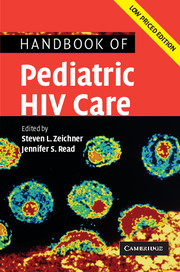Book contents
- Frontmatter
- Contents
- List of contributors
- List of abbreviations
- Foreword
- Preface
- Part I Scientific basis of pediatric HIV care
- Part II General issues in the care of pediatric HIV patients
- Part III Antiretroviral therapy
- Part IV Clinical manifestations of HIV infection in children
- Part V Infectious problems in pediatric HIV disease
- 30 Serious infections caused by typical bacteria
- 31 Tuberculosis
- 32 Disseminated Mycobacterium avium complex infection
- 33 Fungal infections
- 34 Herpesvirus infections
- 35 Pneumocystis jiroveci pneumonia
- Part VI Medical, social, and legal issues
- Appendix 1 Formulary of antiretroviral agents
- Appendix 2 National Institutes of Health sponsored clinical trials for pediatric HIV disease
- Appendix 3 Selected HIV-related internet resources
- Appendix 4 Selected legal resources for HIV-infected children
- Index
- References
30 - Serious infections caused by typical bacteria
Published online by Cambridge University Press: 23 December 2009
- Frontmatter
- Contents
- List of contributors
- List of abbreviations
- Foreword
- Preface
- Part I Scientific basis of pediatric HIV care
- Part II General issues in the care of pediatric HIV patients
- Part III Antiretroviral therapy
- Part IV Clinical manifestations of HIV infection in children
- Part V Infectious problems in pediatric HIV disease
- 30 Serious infections caused by typical bacteria
- 31 Tuberculosis
- 32 Disseminated Mycobacterium avium complex infection
- 33 Fungal infections
- 34 Herpesvirus infections
- 35 Pneumocystis jiroveci pneumonia
- Part VI Medical, social, and legal issues
- Appendix 1 Formulary of antiretroviral agents
- Appendix 2 National Institutes of Health sponsored clinical trials for pediatric HIV disease
- Appendix 3 Selected HIV-related internet resources
- Appendix 4 Selected legal resources for HIV-infected children
- Index
- References
Summary
Introduction
Bacterial infections in HIV-infected children often present in a manner similar to that seen in non-HIV-infected children although these infections occur more frequently, persist longer, have more frequent recurrences and disseminate more readily than in non-HIV-infected children. Because of this increased risk, the US Center for Disease Control and Prevention (CDC) added a new category of invasive bacterial infections to the list of pediatric AIDS-defining illnesses in 1987 [1]. When HIV-infected children present with a suspected bacterial infection, the differential diagnosis is large because the illnesses can be due to opportunistic and endemic infections. These infections include those due to viruses, fungi, mycobacteria, and parasites and can mimic the presentations typically associated with bacterial infections. In addition, bacteria that are unusual in the immunocompetent host may cause significant disease in immunosuppressed HIV-infected children.
Multiple immunologic abnormalities in HIV-infected children and additional factors in resource-poor countries that include malnutrition, micronutrient deficiencies and lack of adequate medical care result in increased susceptibility to infection. Furthermore, certain vaccines against bacterial agents or their toxins administered to HIV+ children often produce antibody titers that are lower and less persistent than that seen in non-HIV-infected children.
The antimicrobial regimens used in the treatment of many bacterial infections in HIV-infected children are often the same as for HIV-uninfected children. Suggested empiric regimens are listed in Table 30.1.
- Type
- Chapter
- Information
- Handbook of Pediatric HIV Care , pp. 653 - 673Publisher: Cambridge University PressPrint publication year: 2006



